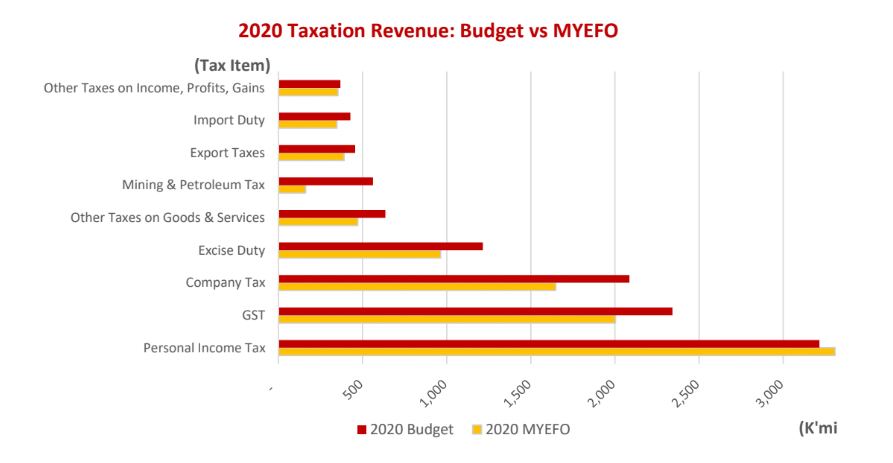Papua New Guinea is increasing its debt by less than other nearby nations and the contraction of its economy is not expected to be as severe as the world average. That is the conclusion of a report by Kina Bank, which describes the rising national debt as ‘tolerable’ as long as the country can strike deals on new resource projects.
The Kina report is an analysis of the government’s Mid-Year Economic and Fiscal Outlook (MYEFO). It predicts that the recession in Papua New Guinea will not be as bad as the global average.
‘The International Monetary Fund (IMF) estimates that the global economy will shrink by 4.9 per cent in 2020,’ the report says. ‘PNG, by comparison, is expecting a relatively modest 2 per cent fall in real GDP.’
The projected increase in PNG’s debt is also less than in other nearby nations, the report says.
‘The 8.6 per cent increase can be compared to the 19.3 per cent increase in Australia’s debt-to-GDP (expected from FY20 to FY21) and the 32 per cent increase in Fiji’s within the same period.
‘Although an increasing debt-to-GDP track is not ideal, in the current circumstance of a recessed economy any major withdrawal of fiscal support will be negative. An increasing track is tolerable if there is a level of confidence that the resource deals that are currently under negotiation, which represent up to US$31 billion (K108 billion) in foreign direct investments, are agreed.’
Quietly confident
The Kina Bank report says that new resource projects will lead to further investment in the country and create ‘a large, multi-year stimulus that will ultimately add to the longer term cash inflows for the country.’ It describes the road to recovery post-COVID as ‘promising, relative to some of PNG’s neighbours’ because of the ‘large’ potential investments.
‘We are quietly confident that the Government and project developers will confirm the US$13 billion (K45 billion) Papua LNG Project late this year, or early next, with some progress being made in discussions.
‘This major infrastructure spending will augment expected foreign direct investments and provide a foundation for economic development and stabilisation to the economy.’
The report also argues that another positive for the PNG economy is a number of planned infrastructure investments: a transnational highway network, telecommunication infrastructure, ports, roads, runways, electricity, water supply and sanitation. These infrastructure projects were scheduled to be implemented between 2020 to 2025 before the onset of COVID-19.
‘This major infrastructure spending will augment expected foreign direct investments and provide a foundation for economic development and stabilisation to the economy. The scheduled commission and associated Government expenditure of these projects fortuitously coincides with the current and medium term need for fiscal stimulus post-COVID.’
Challenges
The Kina report notes that the government will face financial challenges, observing that tax receipts are expected to fall short by 14.7 per cent. Donor grants remain unchanged but other revenue will fall by 58 per cent.
It says that lower levels of company tax, and mining and petroleum tax, are responsible for 96 per cent of the taxation shortfall. Personal Income Tax (PIT), by contrast, is expected to increase due to the ceasing of GST (Goods and Services Tax) Credit Offsets for companies.
The report argues that the medium outlook is positive, however.
‘All things considered, PNG is in a reasonable relative position but investment from resource projects is a pre-requisite to medium term economic growth.’









Speak Your Mind